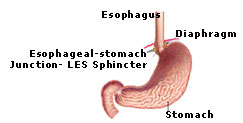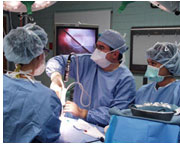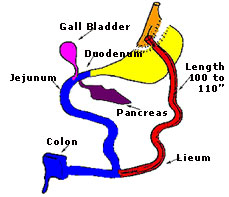|
 , ,
Font size |
Stomach-stapling for successful weight loss
According to recent publication "A certain type of
stomach-stapling surgery, in which the stomach is completely and vertically
partitioned, appears to be linked to a sharp decline in appetite-enhancing
hormones"
 During normal digestion, food moves into the stomach from the
esophagus. While in the stomach, the food is broken down by juices in the
stomach. This process takes about twenty to thirty minutes, after which the
stomach contents move to the first segment of small intestine. Most of the iron
and calcium in the foods we eat is absorbed at this time. The remaining segments
of the small intestine complete the absorption of almost all calories and
nutrients. The remaining food particles that cannot be digested in the small
intestines are stored in the large intestine until eliminated. During normal digestion, food moves into the stomach from the
esophagus. While in the stomach, the food is broken down by juices in the
stomach. This process takes about twenty to thirty minutes, after which the
stomach contents move to the first segment of small intestine. Most of the iron
and calcium in the foods we eat is absorbed at this time. The remaining segments
of the small intestine complete the absorption of almost all calories and
nutrients. The remaining food particles that cannot be digested in the small
intestines are stored in the large intestine until eliminated.
Stomach stapling is a major surgical procedure for severely
and/or morbidly obese individuals who have made numerous, unsuccessful
attempts with traditional methods of
losing weight (e.g., changing eating
patterns, working with nutritionists on
eating plans,
dieting, regular
physical activity), all with the knowledge and supervision of their primary
care provider.
|
The Roux-en-Y operation provides a restrictive and malabsorptive
method to weight loss because the stomach and small intestines are reconfigured.
Roux-en-Y gastric bypass is the current gold standard procedure for weight loss
surgery. It is the most frequently performed operation for weight loss in the
United States, accounting for more than 90% of all weight loss surgeries.
-
 First, a "mini stomach" is created by permanently dividing the
stomach, creating stomach pouch that can hold about 2-3 bites of food. First, a "mini stomach" is created by permanently dividing the
stomach, creating stomach pouch that can hold about 2-3 bites of food.
-
The intestines are then cut approximately one and one half
feet beyond the stomach and attached to the pouch to provide an outlet for the
food.
Instead of food staying in the stomach for the "normal" twenty
to thirty minutes, it now stays in the "mini pouch" for about ten minutes, then
moves on to the small intestine. Besides the pouch gives a sensation of fullness
for a longer period of time.
This bypasses the mixing of food and digestive juices from the
distal stomach resulting in poorer absorption of calories and nutrients. This
both restricts food intake and interferes with absorption resulting in more
consistent weight loss, but has a higher risk of complications or side
 effects.
80% of patients lose at least half their excess weight with the RYGB procedure. effects.
80% of patients lose at least half their excess weight with the RYGB procedure.
The laparoscopic RYGB averages a 3-4 day hospitalization with a
return to full activity in 7-10 days. A liquid and soft diet high in protein is
suggested for 4 weeks after surgery, then the patient is placed on a solid diet.
Roux-en-Y Gastric Bypass Weight Loss Surgery Benefits
-
One year after surgery, weight loss can average 65-80% of excess weight
-
After 10 years, 50-60% of excess body weight loss has been maintained by
some patients.
-
Associated medical problems, such as
diabetes,
hypertension, sleep apnea,
joint pain, and
heartburn are improved or resolved in more than 90% of
patients
Roux-en-Y Gastric Bypass Weight Loss Surgery Risks
-
Because the duodenum is bypassed, Poor absorption of
iron,
calcium, and
vitamin B12 can result in deficiencies. Metabolic bone disease can also occur
but all these problems can usually be prevented by vitamin and mineral
supplementation but is especially important for patients who experience
chronic blood loss or are prone to
osteoporosis. prevented by vitamin and mineral
supplementation but is especially important for patients who experience
chronic blood loss or are prone to
osteoporosis.
-
Dumping syndrome can occur as the result of rapid emptying of stomach
contents into the small intestine which usually happens if too much sugar is
consumed. While generally not considered to be a serious risk to your health,
the results can be extremely unpleasant and can include nausea, weakness,
sweating, faintness and, on occasion, diarrhea after eating.
-
The bypass portion of the stomach, duodenum and segments of the small
intestine cannot be easily visualized using x-ray or endoscopy if problems
such as ulcers, bleeding or malignancy should occur.
-
In some cases, the effectiveness of the procedure may be reduced if the
stomach pouch is stretched and/or if it is initially left larger than 15-30cc.
-
Risks of surgery include infection, bleeding, blood clots, leaks,
strictures, and bowel obstructions. In general, the benefits of gastric bypass
outweigh the risks for people with a
BMI > 40, or for people with a BMI of
35-40 and the presence of medical problems associated with obesity.
Dated 01 July 2013
Related Links
|









